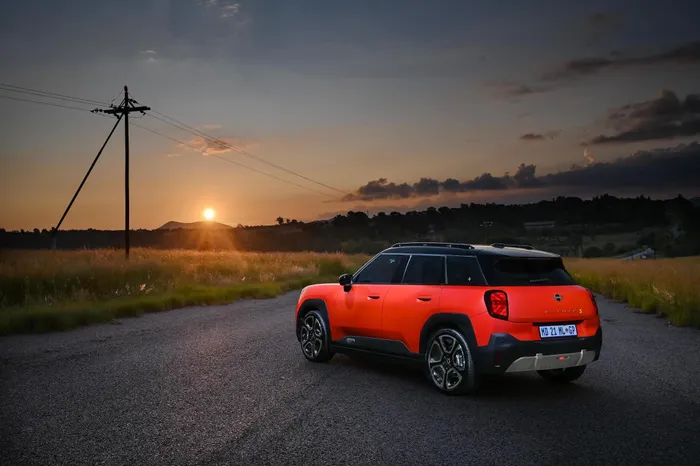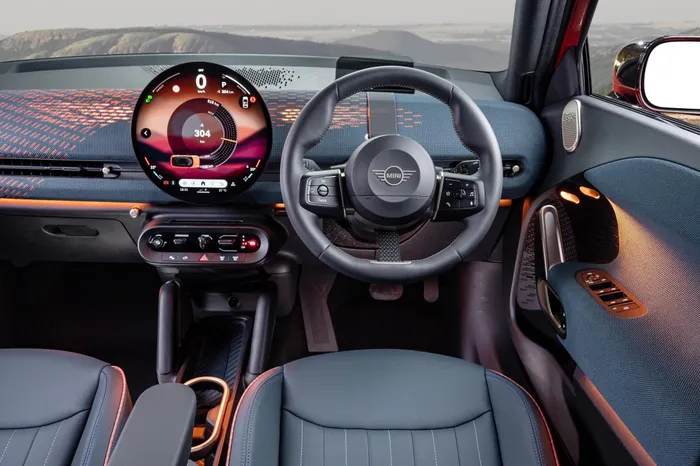Driving impressions: the Mini Aceman combines classic design with cutting-edge electric performance

In the Mini hierarchy the Aceman sits between the Cooper and the Countryman and is the result of a joint venture with Chinese manufacturer Great Wall Motors.
Image: Supplied
When Sir Alec Issigonis famously first sketched a small car on a napkin, little did he know how popular the Mini would become, and he definitely didn’t have a clue what an Electric Vehicle was either.
Fast forward 65 years or so, and you struggle to read a vehicle review without the words New Energy Vehicle (NEV).
Not so small
This is one of those reviews, and it is the Battery Electric Vehicle (BEV) Mini Aceman.
In the Mini hierarchy, the Aceman sits between the Cooper and the Countryman and is the result of a joint venture with Chinese manufacturer Great Wall Motors using the Spotlight EV architecture.
It’s also not a small car by the original brief, standing at just over four metres long with a boot capacity of 300 litres that expands to 1,005 litres with the rear seats folded, while front headroom is said to be 1,003mm and rear 958mm.
Power
There are two variants of the Aceman: the E and the one we had on test, the SE.
With a permanent magnet synchronous motor coupled with a 54.2kWh lithium-ion battery, it produces 160kW and 330Nm and is good for a 0-100km/h time of 7.1 seconds.
It will accommodate DC charging of up to 95kW, which should take about 30 minutes to get from 10-80% and an AC charge of five hours and 50 minutes from 0-100%.
Fully charged, Mini says it should have a range of 400km, but in the real world, depending on how you drive, it’s closer to 330 km.
Exterior
There’s still no denying that it very much still has the mini design DNA with a combination of sculptured lines and angular surfaces, bug-eye LED headlights, and in this case, roof rails, front and rear skidplates and all-round black plastic cladding appealing to its SUV-type appeal.

Roof rails, front and rear skidplates and all round black plastic cladding gives the Mini Aceman an SUV-type appeal.
Image: Supplied
Interior
The interior also maintains its quirky style and design.
It’s one of the more unique interiors in an almost same-same big screen-dominated interiors.
Continuing its homage to the original Mini, the Aceman’s centrepiece is the round 9.4-inch infotainment system running on their Operating 9 system.
The display is easy to use and quick to respond with clear graphics.
The “floating” door handles are unique to the Aceman, and they’ve used several different recycled materials with bold accents on the dash and other trim to keep it fun and vibrant.
Like I said, it’s unlike anything else out there.
The remodelled toggle bar has a proper tactile feel to it and allows you to switch between eight driving modes that include Core, Personal, Vivid, Green, Timeless, Balance, Trail and Go-Cart, which enhances throttle response.
Each mode has its own unique sound, with Go-Cart providing a ‘whoohoo’ voice when selected.
Using Green Mode and driving gently over the week, the screen said I had managed to save 20 kilometres, which is quickly gobbled up when you switch to Go-Cart.
Driving
As with the entire Mini range, they’re always fun to drive with keen handling and precise steering, and the Aceman is no different.
It’s rather brisk on take-off, but not as gut-wrenching as some other EVs, and that’s a good thing because I think the novelty of the immediate torque jettisoning you forward is starting to wear off.
Thanks to the fairly low centre of gravity, it sits rather well around sharp corners, while stomping on the accelerator quickly takes care of slower traffic.
The ride is rather firm, which does make driving over badly maintained tar and even smooth gravel roads a bit uncomfortable.
When pressed hard in Go-Cart Mode, there’s a motorsport-inspired sound piped into the cabin, which I found intrusive.
On the other hand, my son, in his early twenties, provided a different perspective, saying that it’s a modern, fun electric car aimed at non-grumpy people, unlike his father apparently.
Fitted with lane-keeping assist and adaptive cruise control, highway driving is completely effortless.

The Aceman’s centrepiece is the round 9.4-inch infotainment system running on their Operating 9 system.
Image: Supplied
Different point of view
There was also an interesting conversation I had with a lady that clearly knows her stuff, while charging at a 150kW charging point at a shopping centre close to where I stay.
It was her first look at the Aceman, and she was impressed with how it looked and the interior setup.
Her biggest issue was range anxiety, not so much around town with her kids, but more so over long distances.
She knew that South Africa has a fairly good charging infrastructure, but the usual loadshedding, having to wait while it's charging, and all the other what-ifs came up, as it always does.
She baulked at the R892 000 price tag and said that she would rather spend less money on something similar, like the Mini Countryman (R810,774) or, as a BMW fan, a BMW X1 or X2 and not have to concern herself about EV challenges.
She’s not wrong.
The Mini Aceman is a decent overall package, but is a city-centric car and definitely aimed at a niche buyer looking for something different in the EV shopping cart while still having the characteristic Mini look and feel.
Related Topics: